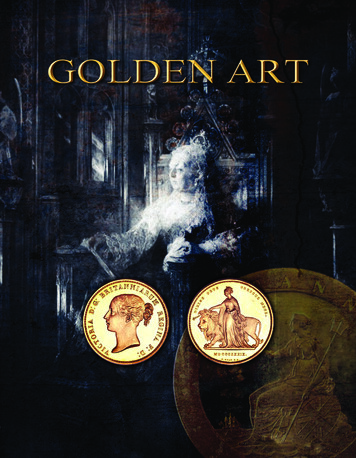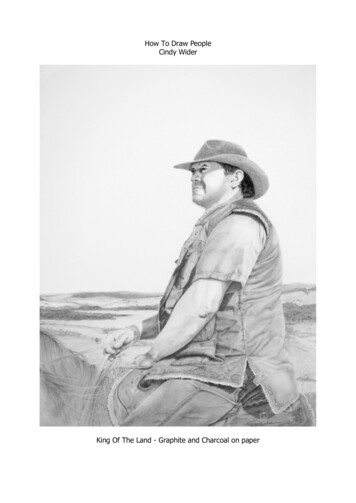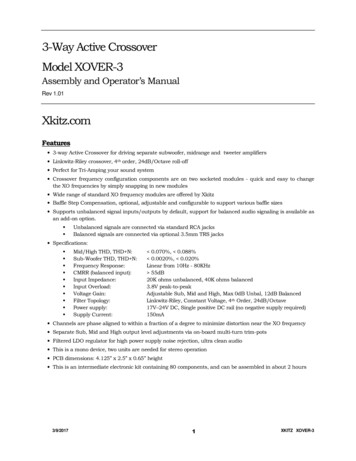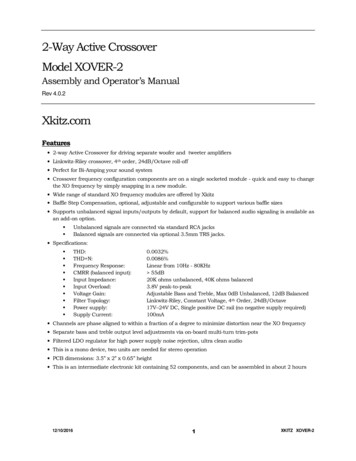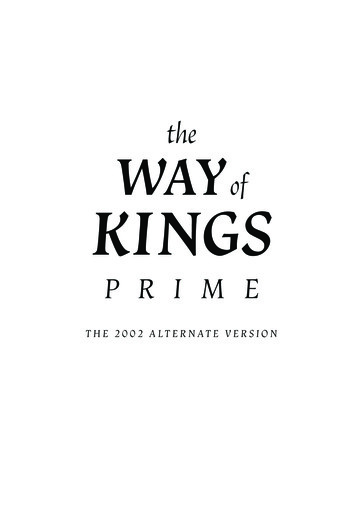
Transcription
theWAY ofKINGSP R I M ET H E 2 0 0 2 A LT E R N AT E V E R S I O N
FICTION BY BRANDON SANDERSON T H E S T O R M LI G H T A R C H I V E The Way of KingsWords of RadianceOathbringerT H E M I S T B O R N S AG ATHE ORIGINAL TRILOGYMistborn: The Final EmpireThe Well of AscensionThe Hero of AgesT H E WAX & WAY N E S E R I E SThe Alloy of LawShadows of SelfThe Bands of MourningT H E R E C KO N E R S SteelheartFirefightCalamityS K Y WA R DSkywardStarsightA L C AT R A Z V S . T H E EV I L LI B R A R I A N SAlcatraz vs. the Evil LibrariansThe Scrivener’s BonesThe Knights of CrystalliaThe Shattered LensThe Dark Talent
N OV E L SElantrisWarbreakerThe RithmatistN OV E LE T T E SFirstbornDefending ElysiumMitosis: A Reckoners StoryN OV E LL A SPerfect StateSnapshotChildren of the NamelessINFINITY BLADEInfinity Blade: AwakeningInfinity Blade: RedemptionC O LLE C T I O N SArcanum Unbounded: The Cosmere CollectionLegion: The Many Lives of Stephen LeedsG R A P H I C N OV E L SWhite Sand, Volumes 1–3Dark OneT H E W H E E L O F T I M E , w i t h R o b e r t J o rd a nThe Gathering StormTowers of MidnightA Memory of LightSANDERSON CURIOSITIESThe Way of Kings Prime
This is a work of fiction. All of the characters, organizations, and events portrayedin this novel are either products of the author’s imagination or are used fictitiously.the way of Kings PrimeCopyright 2020 by Dragonsteel Entertainment, LLCAll rights reserved.A Dragonsteel Entertainment BookPublished by Dragonsteel Entertainment, LLCAmerican Fork, UTbrandonsanderson.comBrandon Sanderson , The Stormlight Archive , Mistborn , Cosmere , Reckoners ,Dragonsteel Entertainment , and the logo are registered trademarks ofDragonsteel Entertainment, LLCISBN 978-1-938570-24-7First Dragonsteel Edition: December 2020Printed in the United States of America0987654321
Sanderson CuriositiestheWAY ofKINGSP R I M ET H E 2 0 0 2 A LT E R N AT E V E R S I O NBRAND ON SANDERSON A D r a g o n s t e e l E n t e r t a i n m e n t B o o k
INTRODUCTIONThis book is both one of my greatest accomplishments and one ofmy greatest failures.I started it during a difficult time in my life. I’d graduated with myundergraduate degree in English in 2000, but had been summarily rejectedfrom every graduate program to which I’d applied. (The book Elantris wasmy writing sample for those submissions.) The publishing industry didn’twant my books either; I’d been racking up a nice stack of rejections sayingmy books were too long.On top of it all, I’d just finished writing what I consider two of the weakest books of my career. (Though later on the ideas from these unpublishedbooks evolved into Mistborn.)And this was when I decided to begin the most ambitious story I’d everattempted.I’ve talked a lot about that time in my life; you might have heard thestory before. I started The Way of Kings because I needed something for me.Something to prove to myself that I still loved writing. After spendingseveral years chasing the market by trying to write like popular writerswho were selling at the time, I asked myself, “What would I most want toread? What would I be writing if I didn’t care what the publishing industrythought?”The book you are now reading is the result. I was told my books were too
viiiPR EFACElong; this is even longer than any book I’d heretofore created. Publisherstold me to focus less on magic and more on creating gritty Earth-like settings, like what was selling at the time. I went off in a completely differentdirection, into a land of knights in magical power armor, ancient magics,and an ecology that was far, far removed from anything you’d find on Earth.To an extent this was me giving up, but in the most glorious way possible.I had realized, during those dark moments, that I loved writing so muchthat I wasn’t going to give up, even if I was never published. The Way ofKings was for me. It was my exploration of my own goals for the fantasygenre—my feelings of where it could go, what it could do—and what I’dlike to see fantasy become.I’ve talked about something my friends jokingly called “worldbuilder’sdisease.” That’s the affliction a writer can get where they spend all theirtime worldbuilding, and never actually tell their story. For The Way of Kings,I decided to GIVE myself worldbuilder’s disease. I let myself just thinkand plan about the world for months and months before writing—far morethan I normally did.At the time, I was working the graveyard shift at a hotel and wouldwrite during downtime. I bought a three-ring binder, and I started printingoff pages of Roshar’s worldbuilding each day after I finished. I filled thatthing up with some three or four hundred thousand words of ideas for thesetting—more words than the book itself eventually had. In part, this wasto give myself time to deal with all the rejections I’d been getting.Things eventually got better. I finally got accepted to a graduate school.(BYU let me in; I hadn’t wanted to apply there initially because that’s whereI’d done my undergraduate studies. However, out of twelve applications thefirst year and another eight the next year, it’s the only school that acceptedme.) I started to see some small successes in publishing. And right aroundthe time I finished The Way of Kings Prime, I finally sold a book.The Way of Kings saw me through it all. It shepherded me through mytransition from an amateur to a professional writer—and the text, as you’llsoon find out, shows that. This book is a failure, but a spectacular one.I’d never attempted something on this scope before, and so I tried towrite too many different viewpoints, with too many different plotlines forme to juggle. The end result, as you’ll read, is a book that lacks focus—it’strying to do too much. What it envisions is awesome, but because of mylimited skill at the time, I ended up with a large number of fragments ofdifferent stories told together in one book—rather than something thattells a single narrative.
THE WAY OF KINGS PRI M EixEverything is going to feel just a little off to you in this novel. Indeed,themes like mental health, which I later learned better ways of addressing,are . . . handled less delicately in this book. Also, in reading history, I foundthat many arranged marriages happened between people of extremelydisparate ages, and I wanted to explore that kind of strange relationship. (Idid it in a way that didn’t involve anything uncomfortable happening—butit still came off poorly in the book. Fair warning.)Almost all the characters are here, though most of them have differentnames. (Jasnah and Dalinar are the only names I remember keeping. AndI don’t believe Navani exists yet.) Kaladin, called Merin in this, has acompletely different arc—as I hadn’t put Bridge Four into the book yet,and hadn’t yet figured out how to make spren part of the world as I wanted.Taln, the Herald, is a main character—I envisioned him as the maincharacter of the series back then, though his arc was supposed to be uncertain, as I didn’t want you to know if he’s actually what he claims, or ifhe’s delusional.The events of this book are far, far different from the published version.So please don’t assume anything in here is still canon, or an indication ofthe future for the real Stormlight Archive—even the name of the serieswas different; I was calling it the Dawnshards. All that said, I’m very proudof this novel. It’s the book I wrote right before Mistborn, and is of a similarquality—just less controlled.It taught me a great deal, however, and I still think it’s worth reading—solong as you understand that the book is an embryonic version of the story Itruly dreamed of telling. I would eventually gain the skill and confidence,after years of thinking about what went wrong, to write the book a betterway. If for some reason you haven’t read the published version, please readthat one first.Despite all its flaws, it’s exactly what I needed when I wrote it. And itis the seed that eventually grew into something great. I hope you findsomething in it to love.Brandon SandersonApril 2020
ACKNOWLEDGMENTSEven though The Way of Kings Prime was never published in the traditional way, it still had a large group of people —friends, family, members ofwriting groups—who read it and gave feedback. Even by the time Elantriswas published, the binders with the printed pages of the book you nowhold in your hands were still being shared around. (In fact, one of thosebinders full of comment-filled pages was literally used as a doorstop whenhelping a friend move apartments.) So, thank you to everyone who read,commented upon, and enjoyed this book throughout the years.For this Sanderson Curiosities edition, big thanks go to Peter Ahlstromand Is c Stewart for shepherding it from manuscript to print. KristinaKugler provided exceptional proofreading and copyediting, for which weare very grateful. We especially want to thank Kristy S. Gilbert at LooseleafEditorial & Production for the book’s layout and design. Her talents andhard work can be seen on every page. Additionally, Isaac Stewart wouldlike to thank Brandon Sanderson for creating the map and symbols thatappear on the next few pages.
This is a map of RosharProper, as it was dividedduring the days of theEpoch Kingdoms. Note that"Shinavar" on this map iscalled "Silnasen," "Vedenar"is called "Jah Keved," and"Pralir" is called "Prallah."NanahRIENARLAITRal EramSVADENLAITNomkhor(The Son)Veden CityDAVARLAITLahkhor(The Daughter)DISTANTPRALLKenedalthe ten epoch inaroShentil'sCrookThe Drunken MountainsKholinarTeth-KanarahannSearFar ComhfCelNahel-Elir'sBayHIGH WATCHINGSRashkah WardenStreatched Bay
THE DOUBLE EYETALN(Stone)RIEM (Stasis)KAV(Wood)KHOR (Time)ISH (Awakening)NOLH(Air)JEZ ment)HRAN(Crystal)BALEV(Oil)NAH (Energy)ZEREM (Thought)SHIN(Water)KHOF(Fire)EKEZ (Life)DAL(Flesh)SHAN (Decay)This is a representation of the Double Eye as it appears in Rosharanart. Sometimes it appears stylized or without glyphs, as seen on the nextpage. Other times the Ten Forces are left out in favor of portraying the TenEssences more prominently.
Part 1
chapter 1DALENAR 1Dalenar could see a highstorm approaching. Its clouds crested thehorizon like a rising wave, dark, silent. It was still distant, but it wouldcome. Furious and exact, highstorms were as inevitable as the rising sun.The wood lurched beneath his feet, and Dalenar reached reflexively forthe tower’s rail. The battlefield stretched below him, a world of screamingmen, metallic rings, and hissing bowstrings.“When we return,” Elhokar muttered from a short distance away,“remind me to find a towermaster who doesn’t see fit to run over everyboulder on the battlefield.”Dalenar snorted quietly, scanning the battlefield. Spearmen in Alethkarblue held in a tight formation around the advancing tower, protecting thewooden structure and using its momentum to help push them forwardas they pressed against the enemy line. Two massive chulls pulled thetower, a fifty-foot high construction of wood and steel. The chulls lumberedforward on trunk-like feet, encased in stone—the great northern beastsused massive, hollowed-out boulders like shells to hide their tender bodies.They didn’t even seem to notice their harnesses at their necks or the menscurrying at their feet.The tower did its job well. Its two tiers of archers launched volley aftervolley of missiles at the enemy. Dalenar looked down at the soldiers, wondering what it would be like to be a simple footman facing the enormous
4BR AND O N SAN DE RS ONstructure. The unfortunate men were forced to choose between holdingtheir shields up high to block the death from above, or holding them lowto block the spears in front of them. The discarded bodies, left in heapsbehind the advancing line, proved that both choices were equally fatal.“Where is he?” Elhokar said, frowning. The king shone in his goldenarmor, one of the finest suits of Shardplate in Alethkar. Gold-trimmedwith sunbursts on the shoulders and breastplate, the armor was topped bya helm mounted with four intricate spikes. Yet, majestic though it was, thearmor looked wrong on the young king. Dalenar still expected a differentface to look out from that helm—a face aged with wisdom, not young anduntested.“He’ll come, your majesty,” Meridas promised with a smooth voice.Dalenar frowned, but said nothing. The king had a right to choose hiscounselors, and while Meridas was lowly of rank, he was still a lord—anda wealthy one. Without Meridas’ s merchant fleets, the king could neverhave moved across the Sea of Chomar in such a short time.Elhokar didn’t respond. His eyes watched the battlefield, yet Dalenarknew he wasn’t planning strategy. Elhokar only desired one thing fromthis battle.And that, unfortunately, left Dalenar to shoulder the bulk of the command. Dalenar turned, waving toward the back of the tower and its smallcrowd of aides, messengers, and lesser lords—Dalenar’s two living sonsamong them. A messenger approached, and Dalenar ordered a squad ofheavy infantry to the eastern flank, to break a particularly resilient groupof Prallan spearmen. The messenger nodded, moving to climb down anddeliver the message.“Where is he?” the king repeated quietly.Dalenar moved up to stand beside the young king, his armored feetthumping against the wood. Dalenar’s own Shardplate wasn’t as intricateas that of his nephew—he hadn’t sewn it with silks, and it bore fewadornments. It suited him, and he had worn it with pride since the day hisbrother had given it to him, so many years ago.“The Traitor will commit himself soon,” Dalenar said with a slow nod,speaking over the sounds of fighting a short distance below. “Your sister’sstrategy is a good one. The Prallan forces are buckling in the east, and theirmen fight with the frantic motions of a group demoralized. If the Traitordoesn’t join the battle soon, he will lose the day
Elantris was published, the binders with the printed pages of the book you now hold in your hands were still being shared around. (In fact, one of those binders full of comment-filled pages was literally used as a doorstop when helping a friend move apartments.) So, thank you to everyone who read, commented upon, and enjoyed this book throughout the years. For this Sanderson Curiosities .

